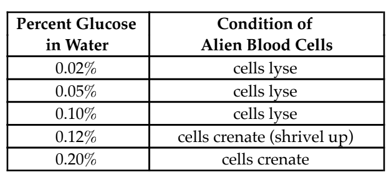Refer to Table 5.1. How can you determine the osmolarity and tonicity of the alien blood and alien cells?
You are walking to school one day when you notice an alien spaceship that has crashed in a nearby field. You and some other physiology students collect samples from the beings inside of the spaceship. First, you collect a liquid sample of what appears to be alien blood so that you can test for the concentration of solutes inside the alien blood cells. You then extract some of these cells, place them in various concentrations of glucose in water, then look at them under the microscope. Below is what happens to the cells when they are placed in various concentrations of glucose:

Quantitative chemical analysis would determine osmolarity. To determine tonicity, drop the cells into various solutions and observe the cells' response under the microscope.
You might also like to view...
The limbs of the body are attached to the axis and make up the
A. antebrachial region. B. thoracic region. C. appendicular region. D. axial region. E. abdominal region.
Germinal cells can most likely divide indefinitely due to the activity of an enzyme called ________.
A. telomerase B. RNA transferase C. DNA polymerase D. caspases
Papillary muscles prevent the AV valves from prolapsing (bulging) excessively into the atria when the ventricles contract
Indicate whether the statement is true or false
The fluid outside of a cell is called ________.
A. cytosol B. intracellular fluid C. nucleoplasm D. extracellular fluid E. cytoplasm